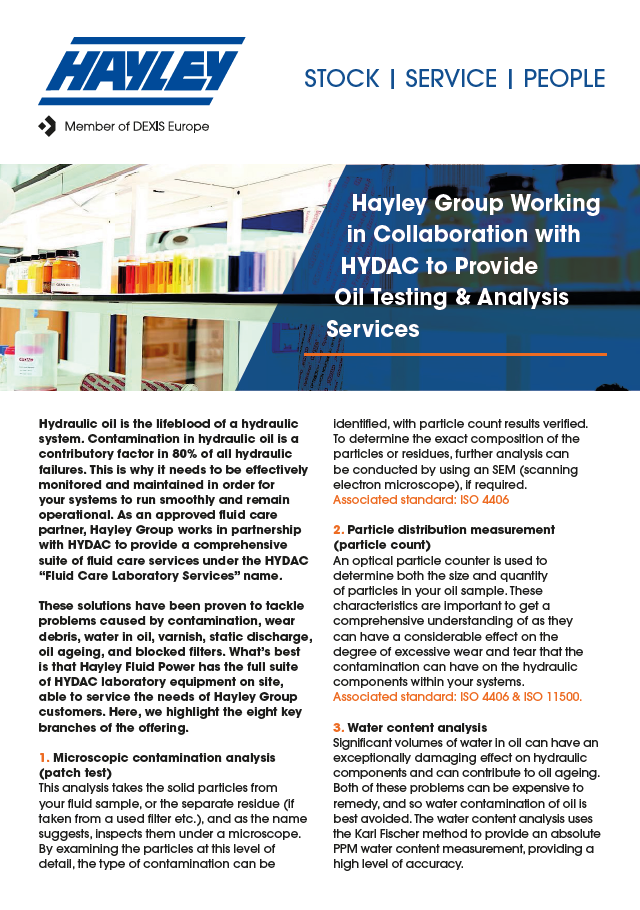Hydraulic oil is the lifeblood of a hydraulic system. Contamination in hydraulic oil is a contributory factor in 80% of all hydraulic failures. This is why it needs to be effectively monitored and maintained in order for your systems to run smoothly and remain operational. As an approved fluid care partner, Hayley Group works in partnership with HYDAC to provide a comprehensive suite of fluid care services under the HYDAC “Fluid Care Laboratory Services” name.
These solutions have been proven to tackle problems caused by contamination, wear debris, water in oil, varnish, static discharge, oil ageing, and blocked filters. What’s best is that Hayley Fluid Power has the full suite of HYDAC laboratory equipment on site, able to service the needs of Hayley Group customers. Here, we highlight the eight key branches of the offering.
1. Microscopic contamination analysis (patch test)
This analysis takes the solid particles from your fluid sample, or the separate residue (if taken from a used filter etc.), and as the name suggests, inspects them under a microscope. By examining the particles at this level of detail, the type of contamination can be identified, with particle count results verified. To determine the exact composition of the particles or residues, further analysis can be conducted by using an SEM (scanning electron microscope), if required.
Associated standard: ISO 4406
2. Particle Distribution measurement (Particle Count)
An optical particle counter is used to determine both the size and quantity of particles in your oil sample. These characteristics are important to get a comprehensive understanding of as they can have a considerable effect on the degree of excessive wear and tear that the contamination can have on the hydraulic components within your systems.
Associated standard: ISO 4406 & ISO 11500.
3. Water content analysis
Significant volumes of water in oil can have an exceptionally damaging effect on hydraulic components and can contribute to oil ageing. Both of these problems can be expensive to remedy, and so water contamination of oil is best avoided. The water content analysis uses the Karl Fischer method to provide an absolute PPM water content measurement, providing a high level of accuracy. but still capable of producing potentially damaging particles, you will need to focus on the type of work being done to understand the risks.
Associated standard: ASTM D6304
4. Conductivity testing
As manufacturers of hydraulic oils have refined their products over time to improve their performance and comply with tightening environmental regulations, the conductivity of oil has decreased. Despite the obvious benefits of this gradual shift, the reduced conductivity of hydraulic oils has left some systems vulnerable to electrostatic discharge. In some cases, this manifests as visible sparking at certain points in the system and can greatly reduce filtration efficiencies and also contribute to oil ageing.
This test calculates the value, in pS/m, of the conductivity of your oil. The results are used to identify whether there is a risk of electrostatic discharge causing issues for your system and make recommendations around the best course of action for you.
Associated standard: ASTM D2624
5. ICP (Elemental) Analysis
Inductively Coupled Plasma (ICP) analysis allows us to identify the ppm quantity of individual elements within a fluid. This analysis determines the causes of any contamination, whether that cause is worn metals or from a different source. It also enables the identification of additive levels in the fluid sample and the subsequent trends. As a result, the rate of depletion can be better understood, with any subsequent oil changes recommended to improve things.
6. Viscosity Analysis
Keeping track of your oil’s viscosity is vital to maintaining the effectiveness of the lubricant and the reliability of your hydraulic systems. If viscosity is too high, excess heat will be generated, with the fluid ageing process accelerated as a result. On the other hand, if it’s too low, hydraulic components may not be being adequately protected, which could lead to excess wear negatively affecting their service life. If it’s found that the viscosity of a fluid is found to have changed over time, then a more in-depth investigation is required as the oil may not be performing to its expected standard.
7. MPC (varnish) analysis
Membrane patch colorimetry (MPC) analysis tracks the volume of insoluble particles present in your oil, endangering your system by risking varnish and sludge build-up in critical components. You can use the outcomes of MPC analysis to plan interventions before any build-ups have the opportunity to disrupt your production. This branch of laboratory services is particularly valuable for mineral-based oils that have been subjected to either high heat or water ingress, as these both contribute to varnish production and premature oil ageing.
8. TAN (total acid number) Analysis
Acids detected in hydraulic oils are a warning sign for oil ageing caused by oxidation. By measuring acid levels for TAN analysis, detected using a potentiometric titrator, the risks of oxidation leading to corrosion and the build- up of deposits can be swiftly tackled before issues occur. If ester-based fluids are being used, TAN analysis can be especially effective as a preventative measure as the rate of acid production is relative to the rate of oil ageing.
These tests are available either individually or as a custom package, and the services available are not limited to those covered here. For more information on how the Fluid Care Laboratory Services offering could help you to take a more proactive approach in maintaining the health of your hydraulic systems.
Is the condition of your hydraulic oil causing your systems to fail? Find-out by allowing us to run our cutting-edge tests and make recommendations. Start the conversation by contacting your local Hayley Group branch.




